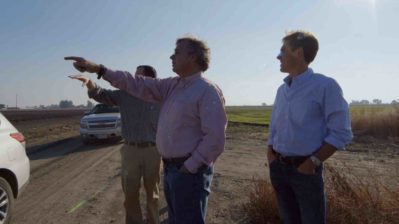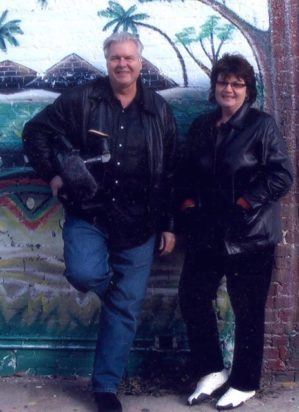INTERVIEW: Veteran documentarians explore water crisis in ‘Killing the Colorado’ project

Discovery Channel is set to premiere Killing the Colorado, a documentary about the fraught issue of water shortages and water rights, on Thursday, Aug. 4 at 9 p.m. The expansive project includes the filmmaking work of several influential documentarians, including Alan and Susan Raymond, the Academy Award-winning team behind such films as An American Family, Police Tapes and I Am a Promise: The Children of Stanton Elementary School.
The Raymonds directed part three of the Colorado River film. Their segment, entitled Water for Sale, looks into the workings of the hedge fund team Water Asset Management and the possibility for a public-private partnership to help western states with their water crisis.
“It was conceived of by the Discovery Impact people, and they decided to assign all of us different stories,” Susan said recently in a joint phone interview with Alan. “Alan and I thought we were best suited for the water traders.”
Alan added: “I think when you first hear about the idea that hedge-fund people are buying and selling water, I think you tend to have a relatively negative view of it. … But I guess what we found spending some time with the hedge-fund guy that we profiled was that it’s actually a more complicated story, and that because of the drought and difficulty now in finding water to supply to the municipalities in the western states, there is going to be I think a need for some kind of public-private partnership in which private capital will begin to participate in the equation. And the example of the wastewater plant that he worked with the people in Arizona to do I think is a positive story, but I just think it’s also the wave of the future. There’s going to be more private capital invested in water and water systems.”
In many ways, their segment in Killing the Colorado runs the gamut from positive to negative tales about decisions and projects that will forever affect local residents in the West. One cautionary tale from the 1970s involves the community of Crowley, Colorado, which is profiled in the Raymonds’ Water for Sale.
“Well, there are obviously ecological issues that get raised when you separate the water rights from the land that it’s attached to, whether it’s a farm or a ranch,” Alan said. “And I think what happened in the ‘70s, which … characteristically is not supposed to happen any longer is that there should be some plan put into place to manage the land after the water rights are separated from it. In the case of Crowley in the 1970s, there was no plan.”
The film is presented in association with ProPublica and based on reporter Abrahm Lustgarten’s award-winning series. The documentary project is meant to educate the public on the often difficult-to-comprehend issue. Water rights cut across the legal system in so many different ways that trying to wrap one’s head around what is allowed, what is disallowed, what is a positive step and what can be detrimental is difficult to decipher. The takeaway from Water for Sale is that in the 21st century water needs to be treated — literally and figuratively — differently than in the past.
“I think in our section for sure we want people to realize that the water now has a great deal of value attached to it, and we now have to manage our water, and not take it for granted and realize there’s this tug of war between the cities and the farmers and who should have the water,” Susan said. “Water is too precious to waste, so we now have to start thinking about how we’re going to use our water, how we’re going to recycle our water and have reuse for it. That is going to be the future. It’s not just going to rain, and we’re going to have water. We’ve got climate change, and that’s what our section is about. It’s about understanding that there’s new ways to use water.”
Alan echoed those comments, pointing out that government officials at the federal and state levels are no longer in the business of building dams or water delivery systems — at least that’s the hope of many people concerned about the environmental impact. This means the water crisis of the West needs some sort of private investment, Alan said.
“I think that the film in general tries to sound something of an alarm bell,” he said. “I mean it’s a very complicated subject: who should get the water, and how the water should be delivered and who owns it. As it said in the film, distribution of water in that part of the country goes back more than 100 years in these early agreements. It’s a complicated matter, but waste water is part of something that will happen I think more and more as cities realize that it’s not that expensive to make those plans and to basically clean up the water. … It’s kind of a yucky idea that you’re taking so-called toilet-to-tap water that people disperse, and then capture it and clean it up, but the technology exists. It’s not a sci-fi thing. It’s something that can be done and should be done, and it’s done in cities around the world as well.”

Perhaps the largest obstacle is attaining a committed buy-in from water users and TV viewers. It takes time — and perhaps repeated viewings of Killing the Colorado — to understand even a fraction of the problem and then settle on some solutions for the future.
“I mean when we started the project none of these words were familiar to us, and it took us quite a while to really dig deep and comprehend everything,” Susan said. “So it has to be very difficult for the public, except if you live in the West. If you live in the West, you’re living with this every day, so I think that the people in the West do understand it a little better than the rest of us. It will have to become familiar jargon for us all because water is scarce.”
Also there’s the issue of how residents view their easy access to water. Although many parts of the world struggle with access to potable water, in the United States, residents often grow up with a take-it-for-granted relationship with the liquid gold coming out of the faucet. People take long showers, douse their lawns, fill pools, wash driveways and keep the sink running when brushing their teeth. To think of this water as something to be saved, as something to be considerate about is a major shift in thinking for many Americans.
“For too many years, it’s just been there,” Alan said. “You turn on your tap, and it’s there. You assume I guess prior to the experience in Flint, Michigan, that it’s perfectly safe to drink and that it’ll always be there, but I think neither belief is necessarily true anymore. It’s not necessarily safe to drink. There are many water infrastructure systems that are very old and that also have lead pipes as part of them. … We’re used to getting water at a very inexpensive rate, and I think as it becomes harder and harder just to create delivery systems and to produce enough water, especially from people who live in cities, they’re going to end up paying more for it, and that’s something that will change.”
He added: “It’s a very serious societal issue. I don’t know that one documentary can really even begin to address all of these complicated issues, but certainly Killing the Colorado is a starting point for the discussion.”
Water for Sale is the first environmental documentary the Raymonds have made, and it appears the filmmaking shift has been a welcome and stimulating one.
“For us, we’ve done a lot of social issues, and it’s been criminal justice, and education and religion,” Susan said. “But now it’s very important to start doing environmental films with environmental impact, and that was new for us. It opened up a whole new world to us because it’s very important. … Our world is changing, and not everyone agrees on it. And it’s complicated. It’s really a good subject for us to jump into and to get familiar with, so that part I really enjoyed.”
She added: “You work really hard on these films. These films are very challenging, exhausting, stressful. All that stuff happens. It’s just good to know it’s going to be broadcast. It’s going to be broadcast on a big network, and it’s going to reach a lot of people. So that’s always good to know that all of this blood, sweat and tears is going to result in something.”
By John Soltes / Publisher / John@HollywoodSoapbox.com
Killing the Colorado will premiere Aug. 4 at 9 p.m. on Discovery Channel. Click here for more information.

